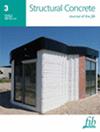混凝土中的紧固与岩体中的紧固--比较测定混凝土中人为制造的不连续面的拉拔荷载
IF 3.3
3区 工程技术
Q2 CONSTRUCTION & BUILDING TECHNOLOGY
引用次数: 0
摘要
地下可能存在的不连续性对后置锚固件的承重性能有很大影响。对于混凝土而言,由于假定混凝土是均匀的紧固基材,因此后置锚固件的行为及其设计可以得到明确的解决。这种假设是有效的,但建筑接缝和预制混凝土构件接缝处除外,在这些接缝处不可避免地会形成结构接缝,基本上相当于一个分离面。相比之下,岩体的特征在于岩石类型,但一般也会受到其不连续性的显著影响。这些不连续性对岩体的稳定性起着决定性作用,并对岩石的承载能力有很大影响,特别是对于埋入深度较浅的紧固件。可以认为,混凝土中的分离面也是如此。此外,问题还在于如何对这些薄弱区域进行非破坏性的初步检测。为了在受控条件下进行比较研究,在实验室试验中,通过在试验构件的不同位置插入聚四氟乙烯层,在混凝土中产生了不同几何形状的人工界面。在其附近对安装后的紧固系统进行了拉拔试验,以确定荷载传递和破坏模式。结果表明,不连续性不仅对岩体的拉拔载荷有负面影响,而且对混凝土的拉拔载荷也有负面影响。不过,只有在岩体中才能通过回弹锤检测到这些不连续性。本文章由计算机程序翻译,如有差异,请以英文原文为准。
Fastening in concrete vs. rock mass—Comparative determination of pull‐out loads for artificially created discontinuities in concrete
Possible discontinuities in the subsurface have a major impact on the load‐bearing behavior of post‐installed fastenings. For concrete, the behavior of post‐installed anchors and thus their design can be clearly addressed as concrete is assumed as a homogeneous fastening substrate. This is valid except, for example, in the area of building joints and at joints of precast concrete elements, where the formation of structural joints inevitably occurs and which basically correspond to a separation surface. In contrast, rock mass is characterized by the rock type, but is generally also significantly influenced by its discontinuities. These play a decisive role concerning rock mass stability and show a great impact on the load‐bearing capacity of rock, especially for fasteners with a shallow embedment depth. It is to be assumed that the same also applies to separating surfaces in concrete. Furthermore, the question arises as to the non‐destructive preliminary detectability of such weak zones. For carrying out a comparative study under controlled conditions, artificial interfaces of different geometries were generated in concrete in laboratory tests by inserting PTFE layers at different positions of the test member. Pull‐out tests of post‐installed fastening systems were carried out in their vicinity to determine the load transfer as well as the failure mode. It could be shown that discontinuities have a negative effect on pull‐out loads not only in the rock mass, but also in concrete. However, detection of these by means of a rebound hammer was only possible in the rock mass.
求助全文
通过发布文献求助,成功后即可免费获取论文全文。
去求助
来源期刊

Structural Concrete
CONSTRUCTION & BUILDING TECHNOLOGY-ENGINEERING, CIVIL
CiteScore
5.60
自引率
15.60%
发文量
284
审稿时长
3 months
期刊介绍:
Structural Concrete, the official journal of the fib, provides conceptual and procedural guidance in the field of concrete construction, and features peer-reviewed papers, keynote research and industry news covering all aspects of the design, construction, performance in service and demolition of concrete structures.
Main topics:
design, construction, performance in service, conservation (assessment, maintenance, strengthening) and demolition of concrete structures
research about the behaviour of concrete structures
development of design methods
fib Model Code
sustainability of concrete structures.
 求助内容:
求助内容: 应助结果提醒方式:
应助结果提醒方式:


